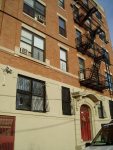On my way to get my hair all prettied up, I passed the Occupy Protesters camped out in Zuccotti Park. I felt a wave of nostalgia. Not nostalgia for my college days (I am a Gen Xer –there was not much we protested). Not nostalgia for my fresh-out-of-college-so-I-am-dirt-poor days in DC. I felt a sense of nostalgia for real activism. I felt a sense of nostalgia for real takeover and occupation of property. I felt nostalgia for the little Casitas built in the South Bronx way back when (well, late 80s).
Since the mid-80s, community gardens have been organized throughout the Bronx in response to the “Bronx is Burning” phenomenon. Specifically, during the mid-’70s, the South Bronx averaged 12,000 fires a year. The burning Bronx left a lot of empty lots, a lot of buildings that became crack havens and a lot of desperate, displaced and depressed people. Community gardening in the Bronx, which at first was actually not community gardening, went on to serve multiple roles, including health-promotion, economic, environmental, and cultural revival. The burning fires were to be tamped down by building “shacks” with one’s bare hands and by taking over those partially burnt down buildings that remained standing. These served as the precursors to the community gardens. Today, there are websites dedicated to community gardens –which is a completely odd concept to me that something so organic (excuse the pun) and so grassroots-oriented would be so systemized and public.
See, while those efforts are great and welcomed, whenever I hear about community gardens I don’t think of these pretty commune gardens, but I think about when certain urban empty overgrown spaces in the Bronx were used by local community residents as shacks that were made to resemble Puerto Rico’s houses. These old shacks were erected by the people and were often hidden from the government. Old buildings were taken over and turned into grounds that resembled the far away land of Puerto Rico. There was no need to publicize them to the world. While current-day community gardens are meant to motivate young and old people to go outdoors, work with their friends and families, learn how to garden and how to grow plants, and experience the joy of connecting with the natural world. The old shacks were ostensibly shanti towns or what the South Bronx Puerto Ricans called ‘Las Casitas‘ (Little Houses) that served to protect the community with a literal cover.
The majority of the Casitas were local gathering spots and the place for local, safe social life. They were built with wooden porches and shutters made from wood panels. The Casitas contained open spaces in front of the houses that mirrored Puerto Rico shanties located in the mountains. In the Bronx, Casitas there were indeed vegetable plants, quenepas, and chickens running around. Oftentimes on the weekends, pigs (lechon) were roasted crispy brown on these oddly built spits. On an aside, one day I had seven little chicks at home, then one day two months later I was eating hairy chicken. Hmm. Soon after that I become a vegetarian (and that lasted over a decade). We would do Christmas parrandas (Puerto Rican version of caroling where you go from home to home with instruments and such) through those Casitas. Eventually, with even the South Bronx going through gentrification, many of these casitas went the way of the dinosaur. Sadly, I knew someone who after becoming homeless moved into one of these casitas tending to it, keeping the casita spirit alive until he died this past year of AIDS. Casitas had served as a refuge, back when I was younger, for those on the fringe and has remained so for those that society has not tended to.
- Una casita en el campo: a casita in the field
- A casita in nyc
- Old Apartment building on 157th street: right at the center of the casita uprising
- PS 29 in the Bronx; right near the first casitas
- Inside a casita of sorts
At the Casitas of yore bomba and plena was oftentimes performed (a traditional percussive Puerto Rican music style). At the time, I actually didn’t know what that type of music was called. All I knew was that it brought us together- us being the local community –block by block. Many years later, actually two decades later, I went to Puerto Rico on a business trip where I got to see the bomba and plena enacted in a professional setting. The bomba and plena were used as a way for people to introduce themselves to the group. At that business meeting in Puerto Rico I then felt nostalgia for the parrandas and the Casitas of the South Bronx. Oh, how the psychological tables had turned.
Somehow we felt safe in those Casitas. I had not yet been to Puerto Rico when these Casitas were beginning to sprout throughout the Bronx. These casitas symbolized a sense of nostalgia and perhaps disconnect that many of the adults in the neighborhood felt. For the children, it represented a mini paradise or as I would call them giant doll houses. Casitas represented a promise. I didn’t quite know what the promise was. But I knew that I yearned to one day have a giant doll house that I could escape into with my toys (which weren’t really dolls but instead games such as Connect Four).
The Casitas also had murals, santos and shrines. These items, for some individuals, just were there for decoration, while for others the items had an actual spiritual/religious use. There were even velitas. Some people would go to the casitas for spiritual healing instead of going to church. This sense of spirituality was oddly mimicked or rather replicated in the summertime when there were tent revival services. These were big meetings under a big top tent. Now that I have come to travel much in the Deep South, I have a better understanding of what it was that I sat through those long summer nights. These were actual attempts to evangelize the South Bronx that many of us would attend as part of yet another community safe haven and event. But that’s another blog topic.
In 1910, only 500 people of Puerto Rican descent lived in New York City. Then mid-century there was a huge migration of Puerto Ricans to New York City. And they brought with them vast traditions, dreams and aspirations. The casitas represented those aspirations and they also represented a sadness –a sadness at how long it was taking to reach those goals. So, the Casitas were built and the piraguas and coquito stands were set up. The government tried to tear many down but the will of the people stood strong. That is what I was nostalgic for. There was a real sense of what was needed and a will, a energy, a vision and also a sense of playfulness. Long live the Casitas.
Categories: current events, History










If your in New York before Sept, 2014 there is a photography exhibition at El Museo del Barrio that includes 42 images from the South Bronx you might find of interest.
I am also working on several film shorts about Puerto Rico, the first of which tells the story of Vieques through the eyes of a 7 ear old boy.
LikeLike
How cool. Thanks for telling me about it and congrats on your project!
LikeLike